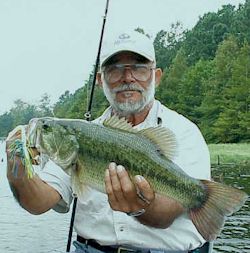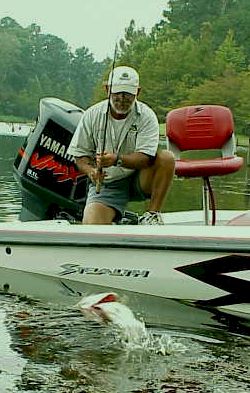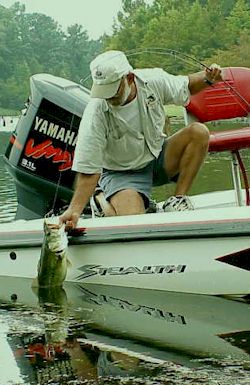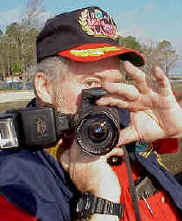Lakecaster Online Archives – February, 2000
-(From Pre-spawn to Post-spawn)-
January 24, 2000, Lake Toledo Bend, TX/LA.
As we cruise in from the windy chop of mainlake waters to the more protective waters of Indian Mounds, I begin to settle into the comforts of what is to become an enjoyable fishing trip with one of Lake Toledo Bend’s most amiable of fishing guides. Just being able to fish for mid-winter bass without having to worry about ice, snow, or frozen bass-i-tudes becomes a pleasent bonus as my day launches into the realm of Noe “No-Way” Garcia, and with the chill of our pre-dawn launch quickly warming to the shimmer of a Louisiana sunrise Noe begins to navigate his Stealth bass-rig into a creek area, “where, after one look at his electronics, he sets the troll-motor and whispers….. “They’re here!”
To the more northern climates, mid-winter means two foot ice-ups and sub-zero blizzards, but here, on Lake Toledo Bend’s sprawling 184,000 acres of “open” waterway, neatly tucked betwixt a scenic 1200 mile shoreline of East Texas and West Louisiana, mid-winter is “now” when January begins to ease into February. To most bass anglers in the know, the months of Jan/Feb means the start of primetime bassin’ on Big “T” as spawn-urged bass start to migrate towards their habitual spawning areas. Typical to our southern climes, normal weather patterns during mid-winter/early spring fishing trips can have temperature swings of from 36 degree a:m/bites to 65 degree p:m/bites -(with 45 degree to 75 degree days not uncommon)-, which allows for some pretty interesting fishing patterns as bass react favorably to these temperature swings which invariably warm to the pre-spawn, spawn, and postspawn patterns of Primetime bassin’.
“Anytime from January 15th on, Noe Garcia begins to enlighten to my notes, adding, “you can expect to see the bass start their spawning migrations as they move up from their deepwater wintering areas while staging along entry points of the flats, banks, and creeks that lead back into their spawning areas.”Down here, Noe continued, “on the south-end of Toledo below the Pendleton Bridge, “we’ll start looking for them when they start holding along the northern banks, or flats, as these are the areas which will start to warm up first. “The magic temperature that we’re looking for then, Noe informed, “is from 58 degrees up, when the bucks -(males)- begin to move up onto the bedding areas. “We’ll usually find them bunched up in suspended patterns just off the points at this time, Noe advised, “as we’ll start fishing for them with red, orange, or crawfish patterned crankbaits in “sloooow” retrieves of “reel-pause, “reel-pause, “reel-pause, which will be the key factor for success during this time. “The bucks will usually be 2 lb class fish which will begin moving onto the warming flats to start cleaning out the beds in preparation for the larger egg-laden females to arrive. “The spawning females will usually be from 4 lbs to over 10 lbs, Noe advises, stating that the bigger females will begin arriving when the water starts warming up into the 60’s. “Carolina rigged watermelon/chartreuse lizards are my favorite rigs to fish with at this time, Noe informs, explaining that he’ll start working the lizards in the far back coves of creeks, flats, or sloughs.
As we move into a narrowing creek channel flanked by stubbled fields of gnarled timber-stumps, Noe suddenly connects to our first good bass of the morning on a slow-rolled spinner-bait as he lands a solid 5 lb bass. “Nice bass, Noe quickly admires to my camera’s lense, “see how dark and well marked it is, he appraises, speculating that it’s a female who’s been cruising the flats looking for a suitable spawning bed. “She’s not quite ready to spawn as yet though, Noe further advises, explaining that the bass was probably weeks away from doing her thing. After carefully releasing the pre-spawner, Noe troll-motors towards the back of the creek area which opens up into a widening slough.
“My favorite places to fish during these pre-spawn, spawn, and post-spawn periods, Noe tells, “is here at Indian Mounds, but also the Palo Gaucho, Housen Bay, Arnolds Bay, Pirates Cove, and Tennessee Bay areas, with Tennessee being excellent for the Spring-time spawners. “Lananna Bayou, located above the Pendleton Bridge, is also very good, Noe pointed out, “but Lananna’s a little different from the others as there’s no grass, but has steep brushy dropoffs which are ideal for Rat-L-Trap and Spinner Bait anglers. “San Miguel is also an excellent spawning area, Noe further added as an afterthought, “but I much prefer to fish the more southerly structured waters.
“When the water finally warms up into the 60’s, Noe explains, “the larger females, now swelled with eggs, will start cruising the spawning areas in search of nesting males which may attract their spawning interests. “This is the time to switch over to flukes, wacky worms or jig n’craw type baits, Noe advises, explaining that, “in some cases you’ll be able to spot the bedding bass which are in the shallows, but for the most part you’ll not be able to do this as most bass will be hiding in heavy brush during their spawning activities. “Bass will usually take up to 10 days to spawn, Noe educates, “and will often spawn several times in several different nesting areas within that period of time. “This is “Ma” Nature thing, Noe informs, advising that the bass spread their eggs around in several nesting areas to insure its genetic survival, “kinda’ like spreading your eggs in more than just one basket, stated Noe. “The bass won’t be actively feeding at this time, Noe explains, “but will be trying to protect their nesting areas by killing and removing pests and predators from their nests. “This is why the soft plastic type baits work so well at this time, Noe pointed out, “as the bass recognize the lizard as a predator and will try to kill them before moving them off their nests. “You’ll usually only see a suttle “twitch” of your line when the bass clamps down on the bait to kill it, Noe advises, “then you’ll see your line moving off a little as the bass removes it from the nest. “The trick is, Noe educates, “to try and set your hook right when you see that “twitch”, but this isn’t fool proof as often times the bass won’t even have the “hooked” end of your bait fully within its mouth. “This is why its important to use a line that is visable to your eyes, Noe tips, “as you must be able to see that suttle “twitch” in order to catch that bedding bass.
“March is probably the best time to fish for bedding bass, Noe informed, adding that the primetime spawn will be in full bloom by then and will offer the best chances for catching a trophy lunker bass of 10 lbs or more. “Toledo Bend probably has one of the finest trophy bass programs in the Nation, Noe informs, “as the Sabine River Authority of Louisiana provides a lunker program which allows for “live”10 lb bass, and above, to be recovered and donated into their program for live release back into the lake, awarding the angler an exact replica mount, and a certificate of merit for releasing their lunker catch. “The key word here “is “conservation” of our natural resources, Noe explains, “as Toledo Bend actually enjoys three lunker programs with the States of Louisiana and Texas operating “share-a-lunker” type programs which recover 13 lb “plus” lunker bass which are then transported to the hatcheries for genetic study. “Again, Noe notes, “the angler who donates their “live” lunker bass to these programs will receive exact replica mounts as well as other prizes and awards. “Our Toledo Bend lake record largemouth bass of 14 lbs-11ozs was a Louisiana lunker program entry, Noe informs, adding that the huge bass was released alive and healthy back to the lake after being carefully studied by the Louisiana fishery biologists.
“So, Noe reviews, “we’ll have the bucks come in first at about Jan/Feb to start cleaning up the nests in preparation for the spawning females, then the females will move in about Mar/Apr to start bedding with the males as their eggs are fertilized for hatching. Then the females will move back to deepwater after spawning, leaving the males to protect their nests and hatchlings. This will all happen within a three month period of time, Noe informs, adding that the bucks will also begin to move back to deepwater after their protective job is done. “When the males and females finish their spawing activities, Noe advised, “they will be pretty beat up and exhausted from the experience and will go on a postspawn “lock-jaw” phase as they try to rest and recuperate their energies. “This is when they are the hardest to catch, Noe admits, “but, by using finesse baits such as wacky worms, french frys, or trick worms you should be able to entice a strike, or two. “I much prefer the watermelon/red colors at this time, Noe reveals, “with their tails “dipped” in garlic scented chartreuce dyes as this color & scent combination seems to work well for enticing the often-times finicky “post-spawn”strike.
As we move along the brushy edges of the slough, Noe suddenly spots some movement near the bank. “There’s a bass over there working a nesting area, Noe alerts to me. Quickly recognizing a photo opportunity I beg to be dropped off above where the bass is working, and after a hesitant search for gators, snakes, or panthers, I barely have time to step into position before the water in front of me erupts into a “blurr” of splash & flash as the bass lunges at Noe’s lizard. After the bass wildly sprays my camera with watery action images, a grinning Noe Garcia finally subdues the “fiesty” buck before releasing it back to its nesting chores. “That bass was so aggressive to my lizard, Noe chuckled , “that it actually hooked itself while trying to kill it.
“This is what it’s all about, Noe praises, “as we can enjoy some pretty exciting action during this time of year, but also much prefer to release them back so they can continue with their spawning activities. “The spawn” is a very important factor for the future of our lakes bass fishery, Noe advised, “and even though we receive large re-stocks of bass every year-(up to 1 million)- we really do appreciate those anglers who release these spawning bass during our primetime months, which really helps to keep our bass fishery solid for everyone to enjoy. “I have several grandchildren, Noe proudly announces, “and I sincerely love to take them fishing.
Noe Garcia, Bass Tournament Angler, Pro-Fishing Guide, field/editor for LakeCaster Publications, “and” proud GrandPa, can be reached by calling-(318)-645-4029-or- (318)-645-2620 -or by writing to -Noe Garcia/Professional Guide- 130 Commanche- Zwollie, LA. 71449.
(Editors note)- as to the reason for Noe’s nickname of -“No-Way” Garcia- you’ll have to ask him why…… but, maybe it just might have something to do with a 5 lb cricket……..!?)


Noe trys to “un-hook” bedding bass

“oops”
Copyright © 1999 – 2005 by Lakecaster Publications, Onalaska, Tx. All rights reserved. Usage rights granted to Toledo-Bend.Com





 Bassin’ The Bend With Noe “No-way” Garcia
Bassin’ The Bend With Noe “No-way” Garcia